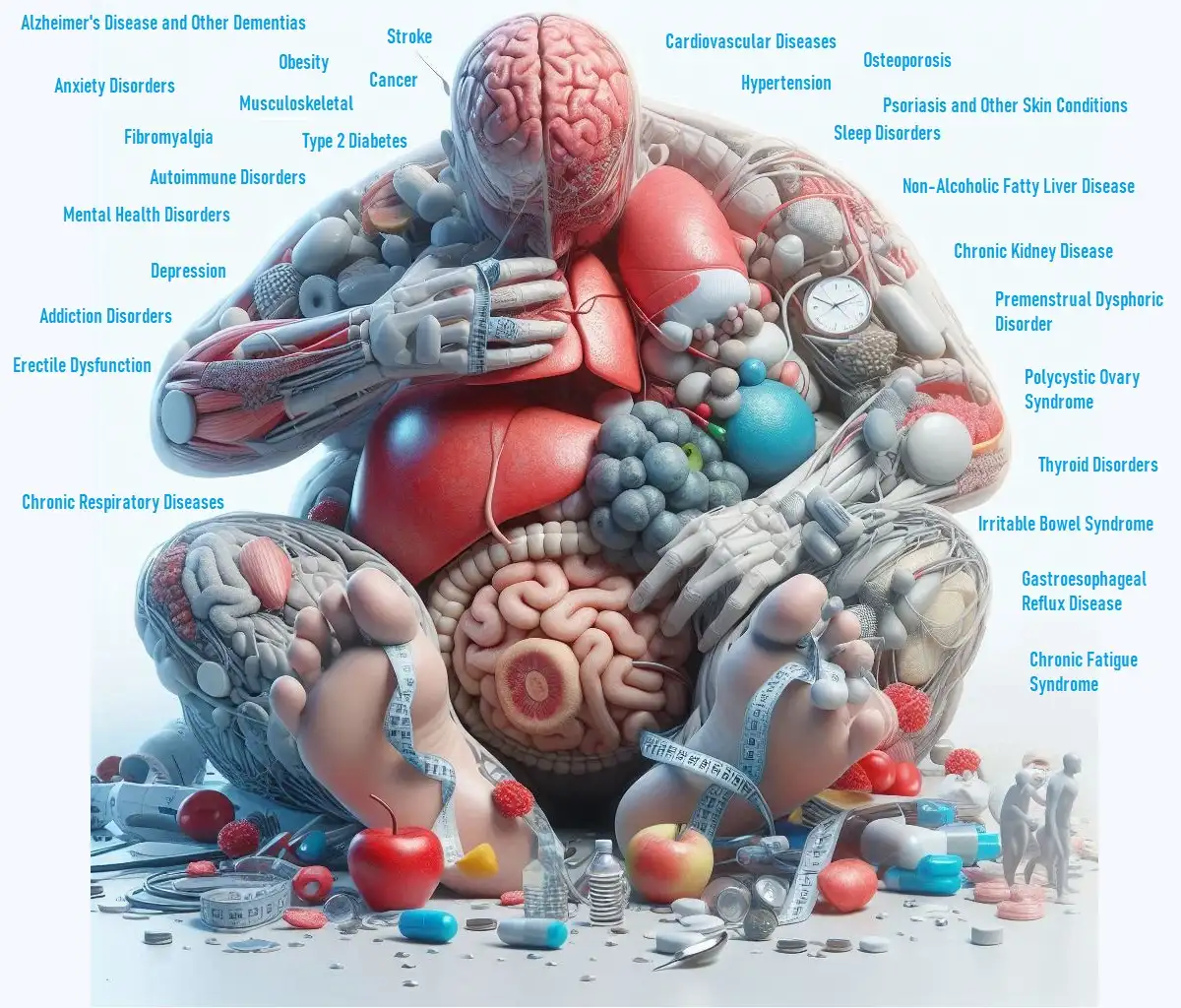
Obesity isn’t just a matter of excess weight—it’s connected to a range of other health problems. From the effects of leptin deficiency to the challenges of managing joint pain and chronic pelvic pain, understanding these links can help you address obesity more effectively. This article will explore how leptin deficiency impacts obesity, the connection between obesity and osteoarthritis, the role of resistant starch in weight management, the relationship between obesity and chronic pelvic pain, and how night shift work influences obesity.
Key Takeaways
- Leptin Deficiency: This condition can make it difficult for your body to regulate hunger and metabolism, contributing to obesity.
- Obesity and Osteoarthritis: Excess weight puts extra stress on your joints, which can lead to or worsen osteoarthritis.
- Resistant Starch: This type of starch helps regulate blood sugar levels and can aid in managing obesity.
- Chronic Pelvic Pain: Obesity can exacerbate chronic pelvic pain conditions, making management more challenging.
- Night Shift Work: Working night shifts can disrupt your body’s internal clock, leading to weight gain and obesity.
Impact of Leptin Deficiency on Obesity
What Is Leptin?
Leptin is a hormone produced by fat cells that helps regulate hunger and energy expenditure. It signals your brain when you have enough energy stored and need to eat less.
How Leptin Deficiency Affects Obesity
- Increased Hunger: Leptin deficiency can lead to constant hunger and overeating because your brain doesn’t receive the proper signals about fat stores.
- Slower Metabolism: Without adequate leptin signaling, your body may slow down metabolism, making it harder to burn calories.
- Fat Accumulation: Persistent overeating and reduced metabolism contribute to excessive fat buildup.
Managing Leptin Deficiency
- Balanced Diet: Focus on a diet rich in fiber, lean proteins, and healthy fats to help regulate hunger.
- Regular Exercise: Physical activity can improve leptin sensitivity and help manage weight.
- Medical Consultation: If you suspect leptin deficiency, consult a healthcare provider for appropriate testing and treatment options.
Obesity and Osteoarthritis: Reducing Joint Pain
What Is Osteoarthritis?
Osteoarthritis is a degenerative joint disease that causes cartilage breakdown, leading to pain and stiffness in the joints.
How Obesity Contributes to Osteoarthritis
- Excess Weight: Extra body weight puts additional stress on weight-bearing joints like the knees and hips, accelerating cartilage wear.
- Inflammation: Obesity often leads to chronic inflammation, which can worsen osteoarthritis symptoms.
- Limited Mobility: Joint pain from osteoarthritis can reduce physical activity, which can further contribute to weight gain.
Reducing Joint Pain with Weight Management
- Lose Weight Gradually: Even a modest weight loss can significantly reduce joint pain and improve mobility.
- Low-Impact Exercise: Engage in activities like swimming or cycling that are gentle on the joints while still providing effective exercise.
- Physical Therapy: Working with a physical therapist can help strengthen the muscles around your joints, reducing pain and improving function.
Role of Resistant Starch in Obesity Management
What Is Resistant Starch?
Resistant starch is a type of carbohydrate that resists digestion in the small intestine and ferments in the large intestine. It acts like fiber, providing various health benefits.
How Resistant Starch Helps Manage Obesity
- Improves Insulin Sensitivity: Resistant starch can help regulate blood sugar levels, reducing insulin resistance and lowering the risk of type 2 diabetes.
- Increases Satiety: Foods high in resistant starch can increase feelings of fullness, helping to control appetite and reduce overall calorie intake.
- Supports Healthy Gut: Fermentation of resistant starch produces beneficial short-chain fatty acids that support gut health and may aid in weight management.
Incorporating Resistant Starch into Your Diet
- Choose Foods Rich in Resistant Starch: Foods like green bananas, cooked and cooled potatoes, and legumes are excellent sources.
- Add to Meals: Incorporate resistant starch into your diet by adding cooked and cooled potatoes to salads or including beans and lentils in soups and stews.
- Balanced Diet: Combine resistant starch with other healthy eating strategies to effectively manage weight.
Obesity and Chronic Pelvic Pain
What Is Chronic Pelvic Pain?
Chronic pelvic pain is a long-term pain in the lower abdomen and pelvis that can be caused by various conditions, including endometriosis and pelvic inflammatory disease.
How Obesity Affects Chronic Pelvic Pain
- Increased Pressure: Excess weight can put additional pressure on the pelvic organs, potentially exacerbating pain.
- Inflammation: Obesity-related inflammation can contribute to or worsen pelvic pain conditions.
- Limited Mobility: Pain and weight gain can limit physical activity, further complicating pain management.
Managing Pelvic Pain with Obesity
- Weight Management: Losing weight can help reduce pressure on the pelvic area and alleviate pain.
- Pain Management: Consult with a healthcare provider for appropriate pain relief strategies, including medications and physical therapy.
- Lifestyle Changes: Incorporate stress-reducing techniques and exercises to improve overall well-being and manage pain more effectively.
Impact of Night Shift Work on Obesity
How Night Shift Work Affects Obesity
- Disrupted Circadian Rhythm: Working night shifts can interfere with your body’s natural sleep-wake cycle, leading to metabolic disturbances and weight gain.
- Irregular Eating Habits: Night shift workers often have irregular eating patterns, which can contribute to unhealthy food choices and overeating.
- Reduced Physical Activity: Night shifts can limit opportunities for physical activity, further contributing to weight gain.
Managing Weight While Working Night Shifts
- Healthy Eating: Plan and prepare nutritious meals and snacks to avoid unhealthy eating during shifts.
- Regular Exercise: Incorporate physical activity into your daily routine, even if it means working out at odd hours.
- Sleep Hygiene: Prioritize good sleep practices to maintain a regular sleep schedule and support overall health.
Conclusion
Obesity is intricately linked to a range of health conditions, each affecting your overall well-being in different ways. From leptin deficiency and osteoarthritis to resistant starch and night shift work, understanding these connections helps in managing obesity more effectively. By addressing these issues through a combination of lifestyle changes, medical consultation, and dietary adjustments, you can improve your health and quality of life.
Taking proactive steps to manage weight and associated health conditions can lead to better outcomes and a healthier, more balanced life. Embrace these strategies to tackle obesity and its related challenges head-on, paving the way for a more fulfilling and healthier future.







